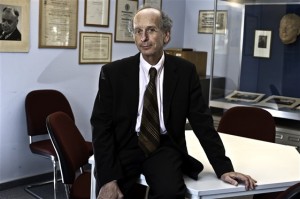
Anne-Marie Brugger (FALC secretary) and Walter Davidson (FALC chair) from the National Research Council of Canada.
The Funding Agencies for Large Colliders (FALC), an informal group of agency representatives, held its 19th meeting at CERN on 6 October. Since its inception, a central role of FALC has been to provide oversight for our efforts towards a linear collider, especially regarding resources. Over the years, FALC has expanded its scope to include a much broader view of future colliders and other international projects in particle physics. For the Global Design Effort (GDE), in addition to providing a general oversight role, it has been responsible for reviewing and approving our common fund. The common fund has been crucial in providing for our central administration, communication efforts including ILC NewsLine, the website and its support, our document and engineering design management system, travel funds and other central support that enables us to coordinate the global effort towards the ILC.
Of particular importance to the ILC was the presentation by the chair of the ILC Steering Committee (ILCSC), Jon Bagger, and a discussion of the ILCSC planning for the evolution of the linear collider efforts following the GDE submission of the Technical Design Report (TDR) at the end of 2012. The planning details will be finalised at the next ILCSC meeting in February, but some features are already emerging. There will be a GDE-like organisation to continue our technical programme beyond the TDR, focused on further development of superconducting radiofrequency systems to higher gradients, including systems tests, as well as selected continuing development in other areas. The design must continue to evolve, keeping a close eye on LHC physics results and the work towards selecting a site.
It is foreseen that the GDE-like organisation will be embedded in a larger linear collider organisation that will also include CLIC and the detector and physics efforts. The ILCSC is working towards implementing the new sub-organisation to replace the GDE, and on a timescale that is supposed to make a smooth transition possible. The completion of the larger organisation, including fully integrating CLIC, will almost certainly take somewhat longer.
Beyond the FALC discussions of the future of the ILC R&D and design efforts, Michel Spiro, President of the CERN Council, reviewed plans for carrying out the update of the European Strategy for Particle Physics. The original strategy began with a preparatory group collecting input from the community that culminated in a symposium at Orsay in France in January 2006. This was then followed by a one-week meeting in May 2006 at Zeuthen in Germany to draft the strategy document. Finally it was approved by the CERN Council on 14 July 2006 in Lisbon, Portugal.
The ILC is included as the fifth item in this European plan for particle physics: regarding the ILC, it says, “It is fundamental to complement the results of the LHC with measurements at a linear collider. In the energy range of 0.5 to 1 TeV, the ILC, based on superconducting technology, will provide a unique scientific opportunity at the precision frontier; there should be a strong well-coordinated European activity, including CERN, through the Global Design Effort, for the design and technical preparation towards the construction decision, to be ready for a new assessment by Council around 2010.”
Our programme has been consistent with this strategy regarding the development of the ILC technologies and design, except that the timing has slipped by two years. As for the European Strategy update, we have been strongly advised (for example, by CERN Director General Rolf Heuer) that we need to bring forward unified ILC and CLIC input. As presented by Michel Spiro, there will again be an open “Orsay-type” symposium, well prepared in advance by a preparatory group (this time the group will include one representative of the Americas and one representing Asia). The group will collect input from the European particle physics community in September 2012, allowing the results of the summer conferences to be taken into account. This means that over the coming six months, we need to continue to work closely with CLIC to develop common inputs.
The final steps of updating the European Strategy will be another “Zeuthen-type” meeting of the European Strategy Group in January 2013 to prepare the Draft Strategy Document for submission to the CERN Council. This will be brought to the Council meeting for approval in March 2013. Finally, there will be a special European Strategy Session of the CERN Council in Brussels in May or June 2013 to adopt the updated European Strategy for Particle Physics.
The other important development at FALC was the naming of the next chair, Yasuhiro Okada of KEK, Japan, and secretary, Nobu Toge, also of KEK (the chairmanship now rotates to Asia). I would like to personally welcome Yasuhiro. We look forward to working with him and to continuing to work constructively with FALC as we complete our TDR and make the transition to a new ILC organisation. The ILC has no home laboratory, so FALC is especially important for us to provide guidance, oversight and support for the ILC before it becomes a real project.
The next meeting of FALC will be from 16 to 17 April 2012 in Tokyo.




Recent Comments